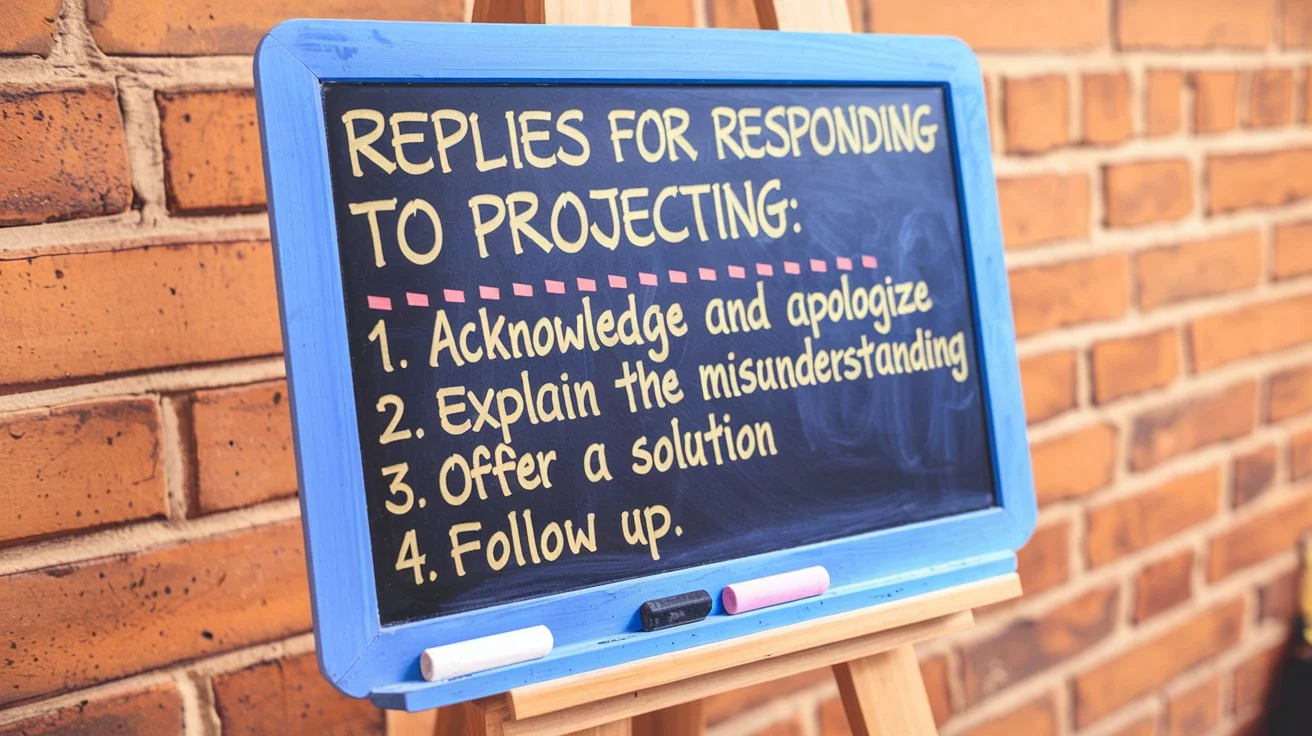Projecting, where someone attributes their own feelings or behaviors to others, can be tricky to handle. Whether in a professional setting or personal conversation, knowing how to respond effectively can help maintain a positive atmosphere and keep discussions constructive.
Here are 30 creative and thoughtful responses to handle projecting with grace and tact.
1. “I see where you’re coming from, but I’m not sure that applies here.”
This response acknowledges the other person’s perspective but gently redirects the conversation back to the relevant topic.
Example:
Person A: You’re avoiding the issue just like everyone else.
Person B: I see where you’re coming from, but I’m not sure that applies here.
2. “Interesting point, but let’s focus on the facts of the situation.”
This reply shifts the discussion from personal feelings to objective facts, which can help depersonalize the conversation.
Example:
Person A: You’re being difficult just like always.
Person B: Interesting point, but let’s focus on the facts of the situation.
3. “I can understand why you might feel that way, but let’s stick to the current topic.”
This response shows empathy while steering the conversation back to the matter at hand.
Example:
Person A: You’re always late, just like everyone else here.
Person B: I can understand why you might feel that way, but let’s stick to the current topic.
4. “It seems like you might be projecting a bit. Can we discuss this openly?”
This reply addresses the projecting behavior directly while inviting an open discussion.
Example:
Person A: You’re being defensive like you always are.
Person B: It seems like you might be projecting a bit. Can we discuss this openly?
5. “I think you might be seeing this through your own experiences. Let’s try to focus on this situation.”
This response acknowledges the other person’s perspective while refocusing the conversation on the current issue.
Example:
Person A: You’re acting just like my previous coworker.
Person B: I think you might be seeing this through your own experiences. Let’s try to focus on this situation.
6. “I hear you, but let’s try to keep our discussion centered on the issue at hand.”
This reply validates the other person’s feelings while emphasizing the importance of staying on topic.
Example:
Person A: You’re always the one to make things complicated.
Person B: I hear you, but let’s try to keep our discussion centered on the issue at hand.
7. “I understand that might be your perception, but let’s address the current problem directly.”
This response acknowledges the perception while redirecting the focus to the immediate issue.
Example:
Person A: You’re always the one to mess things up.
Person B: I understand that might be your perception, but let’s address the current problem directly.
8. “It sounds like you’re projecting your own concerns. Can we discuss this based on our current facts?”
This response gently points out projecting behavior while suggesting a fact-based discussion.
Example:
Person A: You’re acting just like my last boss.
Person B: It sounds like you’re projecting your own concerns. Can we discuss this based on our current facts?
9. “I get that you might feel that way, but let’s focus on what’s actually happening here.”
This reply acknowledges the other person’s feelings but redirects to the current situation.
Example:
Person A: You’re just being contrary like usual.
Person B: I get that you might feel that way, but let’s focus on what’s actually happening here.
10. “I think you might be seeing things from your own perspective. Let’s address the issue directly.”
This response identifies the potential projecting behavior while emphasizing the importance of discussing the issue at hand.
Example:
Person A: You’re reacting just like everyone else who doesn’t understand.
Person B: I think you might be seeing things from your own perspective. Let’s address the issue directly.
11. “It seems like you might be reflecting your own feelings onto this situation. Can we focus on the current facts?”
This reply highlights the projecting behavior while steering the conversation towards the facts.
Example:
Person A: You’re always so negative, like everyone I’ve worked with.
Person B: It seems like you might be reflecting your own feelings onto this situation. Can we focus on the current facts?
12. “I understand that you might be feeling that way, but let’s stick to discussing our current project.”
This response shows empathy while keeping the conversation centered on the project.
Example:
Person A: You’re just like my old team members who never helped.
Person B: I understand that you might be feeling that way, but let’s stick to discussing our current project.
13. “I see you’re passionate about this, but let’s focus on the task at hand.”
This response acknowledges the person’s passion but redirects the conversation to the task.
Example:
Person A: You’re always so difficult, like my last colleague.
Person B: I see you’re passionate about this, but let’s focus on the task at hand.
14. “Your viewpoint might be influenced by past experiences. Let’s address the present issue.”
This reply suggests that past experiences might be affecting the person’s perspective, while focusing on the current issue.
Example:
Person A: You’re just like everyone who’s ever let me down.
Person B: Your viewpoint might be influenced by past experiences. Let’s address the present issue.
15. “It sounds like you might be projecting your own feelings. Can we discuss this from a different angle?”
This response identifies projecting behavior and suggests a different approach to the discussion.
Example:
Person A: You’re being just like my old boss who was always critical.
Person B: It sounds like you might be projecting your own feelings. Can we discuss this from a different angle?
16. “I appreciate your input, but let’s keep our discussion focused on this specific issue.”
This reply acknowledges the input while maintaining focus on the current discussion.
Example:
Person A: You’re acting just like my previous team who always complained.
Person B: I appreciate your input, but let’s keep our discussion focused on this specific issue.
17. “I hear your concerns, but let’s address the specifics of our current situation.”
This response acknowledges concerns while emphasizing the importance of focusing on specifics.
Example:
Person A: You’re always so uncooperative, just like everyone else I’ve dealt with.
Person B: I hear your concerns, but let’s address the specifics of our current situation.
18. “I think you might be interpreting this through your own experiences. Let’s talk about the current problem.”
This response suggests that personal experiences might be influencing the interpretation and redirects to the current issue.
Example:
Person A: You’re acting like all the people who’ve let me down before.
Person B: I think you might be interpreting this through your own experiences. Let’s talk about the current problem.
19. “It seems like you might be projecting your feelings onto this situation. Can we stay focused on the task?”
This reply gently points out projecting behavior while redirecting to the task at hand.
Example:
Person A: You’re being overly critical, like my last supervisor.
Person B: It seems like you might be projecting your feelings onto this situation. Can we stay focused on the task?
20. “Thanks for sharing your thoughts, but let’s concentrate on what we need to accomplish.”
This response thanks the person for their input but emphasizes the need to focus on goals.
Example:
Person A: You’re just like my last coworker who never listened.
Person B: Thanks for sharing your thoughts, but let’s concentrate on what we need to accomplish.
21. “I understand where you’re coming from, but let’s focus on the facts of this discussion.”
This response shows understanding while steering the conversation towards the facts.
Example:
Person A: You’re always so negative, just like everyone I’ve worked with.
Person B: I understand where you’re coming from, but let’s focus on the facts of this discussion.
22. “Your perspective might be colored by past experiences. Let’s address the issue directly.”
This response points out that past experiences may be influencing their perspective and redirects to the current issue.
Example:
Person A: You’re acting like my last team who always missed deadlines.
Person B: Your perspective might be colored by past experiences. Let’s address the issue directly.
23. “I see you might be projecting a bit. Can we discuss this issue objectively?”
This reply acknowledges the projecting behavior and invites an objective discussion.
Example:
Person A: You’re behaving just like my old manager who was always late.
Person B: I see you might be projecting a bit. Can we discuss this issue objectively?
24. “Thanks for your feedback. Let’s focus on the current project to find a solution.”
This response acknowledges the feedback and emphasizes finding a solution for the project.
Example:
Person A: You’re just like all the people who’ve disappointed me.
Person B: Thanks for your feedback. Let’s focus on the current project to find a solution.
25. “I understand that might be how you feel, but let’s keep our discussion focused on this topic.”
This response acknowledges the other person’s feelings while maintaining focus on the topic.
Example:
Person A: You’re acting like everyone who’s ever let me down.
Person B: I understand that might be how you feel, but let’s keep our discussion focused on this topic.
26. “It seems like your past experiences are influencing this view. Can we discuss the current situation?”
This reply identifies the potential influence of past experiences and redirects to the current situation.
Example:
Person A: You’re being just like my last colleague who never contributed.
Person B: It seems like your past experiences are influencing this view. Can we discuss the current situation?
27. “I see you’re bringing in some personal feelings. Let’s focus on solving the current problem.”
This response acknowledges the personal feelings while emphasizing the need to address the current problem.
Example:
Person A: You’re acting like all my previous team members who were always late.
Person B: I see you’re bringing in some personal feelings. Let’s focus on solving the current problem.
28. “Your comment might be influenced by your past. Let’s stay focused on this issue.”
This reply suggests that past experiences might be affecting the comment and directs attention to the current issue.
Example:
Person A: You’re acting just like my last boss who was never supportive.
Person B: Your comment might be influenced by your past. Let’s stay focused on this issue.
29. “I appreciate your input, but let’s address the specific concerns we have here.”
This response acknowledges the input while emphasizing the need to address specific concerns.
Example:
Person A: You’re being just like my old coworker who never helped out.
Person B: I appreciate your input, but let’s address the specific concerns we have here.
30. “It seems like your own experiences might be shaping this perspective. Let’s tackle the current issue directly.”
This reply points out that personal experiences might be shaping their perspective and redirects to the current issue.
Example:
Person A: You’re acting like all the people who’ve let me down before.
Person B: It seems like your own experiences might be shaping this perspective. Let’s tackle the current issue directly.

Dariel Campbell is the driving force behind ReplySwift.com. With a passion for crafting quick and impactful responses, Dariel helps others master the art of effective communication. On ReplySwift.com, he shares expert advice, practical templates, and insightful tips to make every reply count. Join Dariel and elevate your communication skills to new heights.












